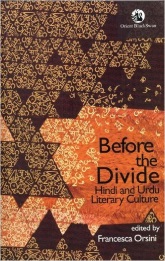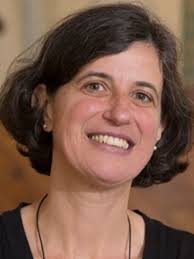Before the Divide: Hindi and Urdu Literary Culture
Francesca Orsini
|
Before the Divide: Hindi and Urdu Literary Culture considers the literary and cultural histories of two languages, Hindi and Urdu, which were deemed separate and distinct from one another under colonial rule. Without denying the rich and complex identity of each language, the book regards Hindi and Urdu’s literary and cultural legacies as not entirely distinguishable from each other, while evaluating the politics that inform the languages’ differentiation. The volume, which includes eight essays on various aspects of the North-Indian (subcontinental) culture and arts, is based on a workshop titled “Intermediary Genres in Hindi and Urdu” that took place at a panel on “North Indian Literary Cultures Before The Divide.” Organized by Professor Vasudha Dalmia (University of California at Berkeley) and Francesca Orsini (School of Oriental and African Studies), the panel was held at the 18thEuropean Conference on Modern South Asian Studies in Lund, Sweden in 2005. Edited by Francesca Orsini, Before the Divide rethinks the linguistic and cultural boundaries between Hindi and Urdu, tackling the important question of the politics of language definition: how and when did Hindi and Urdu come to be defined as two separate, distinguishable languages? Orsini subtly points out in the volume’s introduction that “the issue of language definition was first recognized as a ‘problem’ by colonial linguists” (3). She notes that the rigid classification of Hindi and Urdu as two separate entities was propagated during the time of the Raj (circa 1858-1947) to further Britain’s divide and rule policy. Under this strategy, Hindi and Urdu were identified with Hinduism and Islam respectively, splitting their shared cultural and linguistic influence into two. The language partition was followed by the political and geographical partition of the country in 1947 and the essays in the volume attempt to view the Hindi/Urdu culture in more of a pre-colonial way, as is hinted by the collection’s title. Tracing the nuances of the development of what could be called Hindustani cultural and literary history, the volume starts with a detailed discussion of Rekhta, a mixed register from which Khari Boli, a Western Hindi dialect spoken mainly in the rural surroundings of Delhi, originates. The volume ends with an account of the literary texts composed in Braj bhash, a dialect spoken in the North-Central India, the usage of which has faded over time. The collection thus covers approximately two centuries of linguistic and cultural heritage of what is now North India. The first essay by Imre Bangha, “Rekhta: Poetry in Mixed Language: The Emergence of Khari Boli Literature in North India,” discusses the development of the Rekhta language (rekhta literally meaning interspersed). A musical term, Rekhta was used prior to the eighteenth century to describe a kind of text in which one sets Hindi and Persian words to a raga and tala. During the eighteenth century, Bangha notes, the term was also used to denote a mixture of Khari Boli and Perso-Arabic, the language that later came to be identified as Urdu. Bangha discusses six types of Rekhta adapted by people belonging to various religious communities, citing many poets from early exemplars like Amir Khusro through to the Mughal period poets. He ends this important essay by describing Rekhta as the early shared life of two languages that were eventually separated. The second essay of the volume by Allison Busch, “Riti and Register: Lexical Variation in Courtly Braj Bhasha Texts,” discusses the Riti tradition of literature, which helped to disseminate classical literary ideas in a vernacular language to populations — including Indo-Muslim communities — that had no access to classical Sanskrit ideas. Busch sees the Braj Bhasha Riti tradition as a site for exploring the relationship between linguistic and cultural/religious/political practices. The essay examines the writings of Keshavdas, Chintamani Tripathi, Bhushan Tripathi, Rahim and Raslinand, discussing how Persian terms and Arabic words integrated in Persian vocabulary were paired with words derived from Sanskrit to create a mixed linguistic register, which came to be defined as the Riti tradition. In the end, Busch notes that it is important to understand this unique hybrid tradition in order to reconstruct the literary past of North India and to appreciate the complexity of languages now differentiated as Hindi and Urdu. The third essay, “Dialogism in a Medieval Genre: The Case of Avadhi Epics,” is by Thomas De Bruijn. The essay opens with the observation that the apparent antagonism between the Hindu and Muslim culture in India may not have been present in earlier periods of the region’s history. De Brujin goes on to discuss the case of the dialogic Avadhi epic, which developed as a literary form with the help of both Sufi and Bhakti patronage. In the essay, De Bruijn studies elements from Jayasi’s Padmavat (1540) and Tulsidas’s Ramcaritamanas (1574). He notes that Tulsidas inserted his text in an intertextual framework, the Avadhi epic genre, observing that this type of intertextual interaction allows texts of different religious affiliations to coexist in a dialogic manner that stands in stark opposition to the modern monologic divide between Hindi and Urdu. British colonialists were responsible for initiating the divide between Hindi and Urdu by distinguishing the influences of Hindu Sanskrit and Muslim Persian upon the colloquial Hindustani. Hindi became the language of Hindus and Urdu the language of Muslims only as a result of British intervention, which divided the subcontinent along religious lines. The fourth essay in the volume, “Barahmasas in Hindi and Urdu” by Francesca Orsini, discusses the “intermediary” (142) genre of the barahmasas (poem/song of the twelve months). Orsini says that the genre represents a dialogic category akin to that of the Avadhi epics, observing that texts belonging to this genre are both religious and secular and composed in both Hindi and Urdu. The essay also notes that the barahmasa, which uses the feminine voice, serves as an alternative to and departure from the higher form of the Urdu ghazal, which assumes the male voice. The fifth essay of the volume, “Sadarang, Adarang, Sabrang: Multi Coloured Poetry in Hindustani Music,” is by Lalita Du Perron. The essay looks at the poetry of Hindustani classical music and how it breaks supposed cultural and religious barriers. Du Perron studies the songtexts (although she notes that it is primarily an oral tradition), placing primary emphasis on the religious and erotic love imagery used in khyal and thumri within the Hindi lyric tradition. She observes how, despite the rich and layered poetry of these songtexts, both khyal and thumri remain primarily as musical arts. In “Looking Beyond Gul-O-Bulbul: Obervations on Marsiyas by Fazli and Sauda,” Christina Oesterheld distinguishes the language of marsiya (elegiac verse) from that of the ghazal. She notes that in genres such asmarsiya a larger variety of linguistic registers are encountered than in the highly conventional and stylized world of the Urdu ghazal. The linguistic register used in marsiyas is largely absent from ghazal poetry and almost nonexistent in discussions of Urdu poetry and literature, even though they form an important part of Urdu’s literary canon. The seventh essay of the volume, “Changing Literary Patterns in Eighteenth Century North India: Quranic Translations and the Development of Urdu Prose,” written by Mehr Afshan Farooqi, discusses literary scholars’ dismissal of early Urdu prose texts as religious or moralizing works, rather than as pieces of literatures. Farooqi deems the outright rejection of early religious or didactic prose text incorrect and misleading. She problematizes the exclusion of the eighteenth-century Quranic tafsirs from the canon and argues that historiographical research should look beyond the Fort William episode to other antecedents of the modern Urdu prose. The last essay of the volume by Valerie Ritter, “Networks, Patrons, and Genres for Late Braj Bhash Poets,” discusses Braj Bhasha as a language positioned on the brink of Hindi-Urdu divide and also examines the problem and relationship of patronage, genres and individual poets. Ritter suggests that in the late nineteenth-century literary scene, there were more divisions than just that of Hindi and Urdu. She examines in some detail the work of Hariaudhand and Ratnakar who were working in Braj Bhasha. Eventually Braj Bhasha was no longer recognized as a separate entity and Hariaudhand and Ratnaker’s work was subsumed under the larger Hindi literary canon. The insightful essays in this volume, which survey the literary landscape of the pre-colonial North India, and the politics and problems behind the division of Hindi and Urdu, will prove useful for students and scholars alike. For all those interested in undertaking a more nuanced study of the (literary and cultural) politico-history of both these languages, this is a must-read. A handy guide for enthusiasts of Hindi/Urdu literature, the book offers sharp and intelligent critique of the problems surrounding the history and literature of these two languages. Beginning from Rekhta and ending with Braj Bhasha, the volume recognizes the influence Hindi and Urdu had on one another, without reducing the complexity and nuances of a situation which contributed to the (often unrecognized) issue of the linguistic divide.
Saudamini Deo| Issue 3.2: February 2014 | Inquire Journal of Comparative Literature
|


 Francesca Orsini
Francesca Orsini